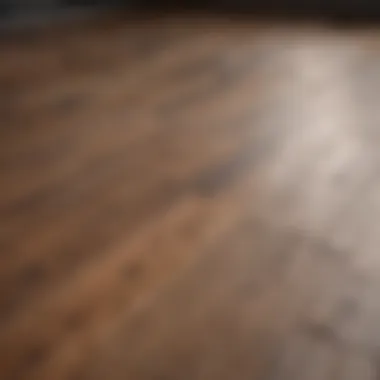Understanding the Costs of Wood Floor Installation


Intro
The decision to install wood flooring in a home is significant. Homeowners are often drawn to wood floors for their aesthetic appeal and durability. However, understanding the costs involved is essential for making informed choices. Various factors influence pricing, from the type of wood to installation methods and labor considerations. This article aims to shed light on these elements, helping homeowners budget effectively while navigating potential expenses associated with their flooring investment.
Design Inspirations
The choice of wood flooring can significantly impact the overall look and feel of a space. A well-considered hardwood floor can become the centerpiece of a room. Thus, exploring design inspirations can enhance the decision-making process.
Trending Styles
Currently, several wood flooring styles have gained traction. Open floor concepts often benefit from seamless transitions between spaces. For example, wide-plank flooring is in vogue, making rooms appear larger and more cohesive. Additionally, reclaimed wood has gained popularity for its rustic charm and environmental benefits. These trending styles highlight the need to consider both aesthetics and functionality when selecting flooring.
Color Palettes
Color choices are equally crucial. Lighter shades can make a room feel airy and fresh, while darker tones add warmth and sophistication. Popular color palettes include cool grays, earthy browns, and rich ambers. Matching the floor color to existing decor can unify a room or add contrast. This choice can affect not only visual appeal but also future resale value, as certain tones may be more desirable for prospective buyers.
Maintenance and Upkeep
Once wood floors are installed, their upkeep requires careful planning. Regular maintenance can preserve their beauty over time. Homeowners should understand what steps to take to prolong the life of their floors.
Seasonal Maintenance Checklist
A seasonal maintenance checklist can be beneficial. Key considerations include:
- Spring: Refinish floors to address any scratches.
- Summer: Monitor humidity levels; excessive moisture can warp wood.
- Fall: Inspect for any gaps that may need caulking before winter.
- Winter: Utilize rugs in high traffic areas to minimize wear.
Adhering to this checklist ensures that flooring remains in top condition regardless of seasonal changes.
Cleaning and Organization Tips
Cleaning practices also play a vital role. Using a microfiber mop prevents unnecessary scratches. Regular sweeping or vacuuming reduces dust build-up. For deeper cleanings, it is recommended to use products safe for hardwoods. Homeowners may also consider organizing living spaces in a way that minimizes dirt accumulation on floors.
"Understanding the cost and maintenance of wood flooring goes beyond installation. It is about preserving the investment through informed choices."
Homeowners and design enthusiasts alike will find this overview valuable. By comprehensively addressing the costs of wood floor installation, one can navigate the myriad options with confidence. With thoughtful planning, wood floors can enhance the home for years to come.
Prologue to Wood Flooring
Wood flooring is not just a choice in decoration; it holds significant value in home improvement and design. It represents a fusion of aesthetics and functionality that appeals to many homeowners and design enthusiasts alike. Understanding its nuances—including types, durability, cost, and installation—offers vital insights for anyone considering this flooring option.
Wood flooring’s warmth and natural beauty can elevate the ambiance of any space. It merges style with practicality, often increasing a property’s market value. However, choosing wood flooring requires careful consideration of various factors, including the specific materials and installation methods. Each choice can significantly influence the overall investment required.
Definition and Popularity
Wood flooring refers to a floor covering manufactured from timber. It adds a touch of elegance and comfort to interiors. Since its inception, wood flooring has seen fluctuating popularity based on design trends and consumer preferences. Today, there is a resurgence in interest, driven by an inclination towards sustainable and natural materials. Many homeowners appreciate that wood is not only visually pleasing but also provides a long-lasting solution suitable for various styles of homes.
Reasons for its rise in popularity include:
- Natural Appeal: Wood flooring offers a unique look to each room, with variations in grains and colors.
- Versatility: It fits well with diverse design aesthetics, from rustic to contemporary.
- Sustainability: Many timber options are sourced from responsibly managed forests, making it an environmentally friendly choice.
Why Choose Wood Flooring?
Selecting wood flooring involves an array of benefits that go beyond mere appearance. It enhances the aesthetic value of spaces and provides functional advantages, such as longevity and ease of maintenance.
Here are some key benefits of choosing wood flooring:


- Durability: When properly maintained, wood floors can last for decades. They resist wear better than carpet or vinyl, making them viable for high-traffic areas.
- Maintenance: Maintaining wood flooring is generally straightforward. Regular sweeping and occasional cleaning with suitable products can keep it looking fresh.
- Allergens: Wood flooring does not harbor dust mites, pollen, or pet dander as carpet can, making it a better choice for allergy sufferers.
Ultimately, the decision to install wood flooring depends on personal preferences, lifestyle, and budget. It is essential to weigh the benefits against costs to make an informed choice.
Types of Wood Flooring
Choosing the right type of wood flooring is integral to the overall project and impacts both aesthetics and cost. Each variety has unique characteristics that affect the installation process, maintenance, and longevity. Understanding these options helps homeowners make informed decisions that align with their personal style and budget considerations. Below, we delve into three primary categories of wood flooring: Solid Hardwood, Engineered Wood, and Laminate alternatives.
Solid Hardwood Options
Solid hardwood flooring, made from a single piece of wood, offers unparalleled authenticity and durability. The thickness of solid hardwood typically ranges from three-fourths inch to five-eighths inch, making it a robust selection. One notable advantage is its potential for refinishing. Homeowners can sand and finish solid hardwood multiple times throughout its lifespan, which can exceed 50 years or more if properly maintained.
Considerations for installation include:
- Moisture sensitivity: Solid hardwood is prone to warping and should not be installed in damp areas such as basements.
- Cost: It is often the most expensive option due to the raw material and labor required for installation, averaging about $8 to $15 per square foot, depending on wood species and local market conditions.
Engineered Wood Flooring
Engineered wood flooring consists of layers, typically three to five, with a top layer of real hardwood. This design provides added stability, making it a better choice for fluctuating humidity levels. It is a suitable option for installation over concrete slabs and in humid environments. The cost for engineered wood range from $3 to $12 per square foot.
Some key points to consider include:
- Ease of installation: Engineered wood can often be floated over existing floors, which can decrease installation expenses.
- Limited refinishing: While it can be sanded and refinished, the top veneer layer is thinner than solid hardwood, limiting the number of refinishing cycles.
Laminate as an Alternative
Laminate flooring is made of composite wood and is topped with a photographic layer that mimics the look of wood. It provides an affordable solution for homeowners who desire the appearance of hardwood without the high cost. Laminate does not require any special maintenance and can withstand heavy foot traffic.
Considerations for laminate include:
- Durability: It is resistant to scratches and fading but cannot be sanded or refinished. Once damaged, full replacement may be necessary.
- Cost-effective: Laminate flooring can cost between $1 to $5 per square foot, making it a budget-friendly option, albeit with less prestige compared to solid or engineered wood.
"Selecting the right type of wood flooring is not just about aesthetic appeal, but also about understanding each option's practical implications regarding durability and maintenance."
Costs Involved in Wood Floor Installation
When considering wood floor installation, comprehending the associated costs is vital. People may underestimate the overall financial commitment required. This segment examines various expenses, including the material costs, labor fees, and additional charges that can emerge during the project. Understanding these factors ensures that homeowners can budget properly and avoid unexpected financial strain.
Material Costs
Material costs form a significant part of any wood floor installation project. These expenses can vary based on the type of wood chosen. Solid hardwood, engineered wood, and laminate all present different price points. Solid hardwood often stands out for its quality and durability but comes with a higher price tag. Engineered wood offers a more cost-effective alternative while maintaining a similar appearance. Laminate, while the most economical option, lacks some of the authenticity and long-term value of real wood. Thus, it is crucial to select materials that align with both aesthetics and budget.
Installation Costs
Installation costs can fluctuate based on several factors, including regional labor rates and the complexity of the job. Homeowners must consider whether they will hire professionals or attempt a DIY project. Professional installation usually guarantees a higher-quality result but will understandably increase overall costs. Labor rates can vary significantly, with some areas commanding higher fees due to demand or cost of living. Moreover, complex layouts, such as patterns or multiple rooms, may require additional time and skill, impacting labor costs.
Additional Expenses
While material and installation costs are primary, several additional expenses can arise. These costs include:
- Subfloor Preparation
- Finishing and Sealing
- Underlayment
Subfloor Preparation
Subfloor preparation is an essential aspect of a successful wood flooring installation. This step involves assessing the current floor's condition and making necessary adjustments. A level and stable subfloor ensures that the wood flooring adheres correctly and maintains its integrity over time. Proper preparation can reduce the risk of future flooring issues. Without it, homeowners may face problems like warping or squeaking. It demands both time and skilled labor, but investing in subfloor preparation pays off in durability and longevity.


Finishing and Sealing
Finishing and sealing wood floors is critical for protecting the material while enhancing its appearance. This process involves applying a sealant that guards against moisture, scratches, and stains. Different finishes offer various aesthetic looks, from matte to glossy, allowing customization. However, the nature of the finish can impact the protection level. Homeowners should choose a finish that aligns with their lifestyle and preferences. Proper sealing prolongs the wood's lifespan and maintains its natural beauty.
Underlayment
Underlayment provides a cushion beneath the flooring, playing a significant role in noise reduction and comfort. Selecting the right underlayment type is crucial for thermal insulation as well. It can also help manage moisture levels in some cases. The material chosen for underlayment comes with its characteristics and costs, influencing the total project expenses. A good underlayment can enhance the overall feel of the floor while preventing future issues.
In summary, understanding the different components of costs involved in wood floor installation helps homeowners make informed decisions. With careful planning, budgeting for materials, installation, and associated expenses ensures a smoother project that meets expectations.
Factors Affecting Installation Costs
Understanding the factors that affect the costs of wood floor installation is crucial for homeowners. Knowing these elements allows for better budgeting and decision-making when planning your wood flooring project. Several important factors contribute to the overall expenses, including geographic location, existing floor condition, as well as customization and design choices. Each of these aspects can significantly influence the final cost, and recognizing their implications will help homeowners avoid unexpected expenses and make informed choices.
Geographic Location
Your geographic location plays a pivotal role in determining the installation costs of wood flooring. Regions with a higher cost of living often translate to increased prices for materials and labor. For instance, urban areas like New York City or San Francisco typically see higher installation rates compared to rural locations. Additionally, local market demand influences the pricing. If wood flooring is a popular choice in a specific area, contractors may charge more due to higher demand. It is essential for homeowners to research prices in their local market and obtain multiple quotes to ensure they get a fair price.
Existing Floor Condition
The condition of the existing floor can also impact installation costs significantly. Before installing new wood flooring, it is crucial to assess whether the subfloor is level and free from damage. If the existing floor requires repairs or leveling, additional costs will arise. For example, issues like moisture damage or structural problems need immediate attention before installation can begin. Homeowners should factor these potential extra expenses into their budgets. In most cases, investing in a solid foundation will enhance the longevity and performance of the new flooring.
Customization and Design Choices
Customization options and design choices can greatly influence the overall installation costs. Homeowners may wish to select specific wood species, finishes, or styles, each carrying different price points. For instance, exotic hardwoods like Brazilian cherry or teak are generally more expensive than standard oak or maple options. Furthermore, intricate design patterns, such as herringbone or diagonal layouts, require more labor and increase installation time, which can lead to higher costs. When planning a project, it is essential to balance personal preferences with budget considerations. Prioritizing essential elements can help achieve the desired aesthetic without breaking the bank.
"Understanding these factors not only aids in budgeting but also ensures that homeowners are well-prepared for potential cost variations during the installation process."
In summation, recognizing the factors that affect wood floor installation costs allows for better preparation and informed decisions. Homeowners should pay attention to their location, existing floor condition, and design choices when estimating costs. By doing so, they can avoid common pitfalls and ensure a successful flooring project.
DIY vs Professional Installation
When deciding on the installation of wood floors, homeowners often face a significant choice: whether to do it themselves (DIY) or hire a professional. This choice impacts the overall cost, quality of workmanship, and the time involved in the project. Evaluating both avenues is crucial for making an informed decision.
Benefits of Professional Installation
Engaging a professional installer for wood floors offers several advantages that can outweigh the initial cost. Here are some key benefits:
- Expertise and Experience: Professional installers possess the skill and knowledge necessary for a proper installation. They understand various techniques that ensure longevity and aesthetics.
- Time Efficiency: A skilled installer can complete the project in a fraction of the time it would take an inexperienced homeowner.
- Quality Assurance: Professionals often provide warranties on their work, offering peace of mind when it comes to potential issues in the future.
- Proper Tools and Equipment: Installation may require specific tools, which professionals already own. Homeowners may not want to invest in these tools if the project is a one-time effort.
"Now and then, investing in a skilled professional could save more money in the long term than attempting the job yourself."
By choosing professional installation, homeowners can avoid potential pitfalls and ensure a smooth, aesthetically pleasing result.
When to Consider DIY
While professional installation has many merits, DIY can be a viable route in certain scenarios. Here are some situations where homeowners might consider taking on the installation themselves:
- Cost Savings: Homeowners on a tight budget may find significant savings by not paying for labor.
- Experience with Home Improvements: If a homeowner has prior experience with similar installations, taking on this project can be manageable and rewarding.
- Availability of Time: Those with weekends or extended periods free might find the time to dedicate themselves fully to the project, ensuring every detail is attended to.
- Personal Satisfaction: Completing a project can be fulfilling, offering a sense of accomplishment that comes from transforming a space with one’s own hands.
Before proceeding with a DIY plan, it’s advisable to assess one’s physical ability and confidence level to handle the intricacies involved in wood floor installation. Both options have distinct advantages and challenges, making it vital for homeowners to weigh their priorities carefully.
Estimating Your Budget
Estimating your budget for wood floor installation is a critical step. This process requires careful planning. Establishing a clear financial outline can prevent overspending and help you prioritize your choices. As wood flooring represents a significant investment in your home, understanding your budget is essential. It not only affects the types of flooring you can choose but also influences installation methods and long-term satisfaction.


The budgeting process should commence with an evaluation of your current financial situation. Identify how much you can comfortably afford. This includes considering your expenses, savings, and any potential financing options. By doing this, you create a framework for your project. This deliberate approach can ensure that your vision for a wood floor aligns with your financial reality.
Calculating Total Costs
To get an accurate estimate of total costs, break down all components of the installation. This means looking at the material costs, labor costs, and any additional expenses that might arise. Start by gathering quotes for different types of wood. Solid hardwood will generally cost more than engineered or laminate options.
Once you have selected your wood type, factor in the installation costs. Labor charges can differ significantly by region or the expertise of the contractors. It’s wise to consult multiple contractors for estimates. Here’s a basic framework on how to calculate:
- Material Costs: Consider both the price of the wood and the quantity needed based on your space.
- Installation Expenses: Each contractor might offer various rates. Compare and analyze.
- Additional Expenses: Don’t forget about costs such as underlayment or necessary preparations.
These details will paint a clear picture of the desired budget.
Planning for Unexpected Expenses
No homeowner wants to be blindsided by costs during the project. Planning for unexpected expenses is both practical and necessary. Some common issues might include subfloor damage, unanticipated delays, or the need for additional materials.
A rule of thumb is to set aside an extra 10-20% of your total budget. This fund can serve as a buffer against financial surprises. By preparing for the unexpected, you maintain control and flexibility in the process.
- Subfloor Issues: Old homes often reveal problems once flooring is removed.
- Changes in Design Plans: Decisions made late in the process can add costs.
- Supplier Delays: Shipping delays can impact your timeline and require you to adjust budgets.
Planning for these situations will give you peace of mind throughout your flooring journey.
In summary, estimating your budget involves careful planning and consideration. Being thorough in calculating costs and anticipating potential expenses will lead to a more successful wood floor project.
Financing Your Wood Floor Project
Financing your wood floor project is a crucial aspect that homeowners must consider. Installing wood flooring can signifcantly enhance the aesthetic appeal and value of your home. However, the costs can quickly add up, demanding a clear financial strategy for many. Understanding how to finance this long-term investment can alleviate financial stress and ensure you acquire the right products and services.
Homeowners often face decisions regarding budget allocation. Considering your options can lead to smarter investments. Moreover, it provides peace of mind knowing that you are managing your finances effectively. An organized approach allows for better control over overall expenses.
Budgeting Tips
When planning your wood floor installation, an organized budget is fundamental. Begin by estimating all possible costs associated with the project. Here are some effective budgeting tips:
- Determine Flooring Choice: Assess the type of wood flooring you desire, such as solid hardwood or engineered options, and their costs.
- Calculate Installation Expenses: Include labor costs, which can vary greatly based on location and complexity of installation.
- Include Additional Costs: Consider expenses like underlayment and finishing, which can add to the overall budget.
- Set a Contingency Fund: Allocate 10-15% of your budget for unforeseen costs that may arise during the installation process.
Keeping a detailed spreadsheet can help track your spending and ensure that no aspect is overlooked.
Available Financing Options
Choosing the right financing option can make a significant difference. Here are some common solutions you might explore:
- Personal Loans: Many banks and credit unions offer personal loans for home improvement projects at competitive interest rates.
- Home Equity Loans: If you have built equity in your home, a home equity loan could provide the necessary funds with potentially lower interest rates.
- Credit Cards: Using a credit card may be feasible for smaller projects, but be cautious of high-interest rates that can accumulate.
- Store Financing: Many flooring retailers offer financing plans that allow you to make payments over time, often with promotional interest offers.
Important Consideration: Always read the terms and conditions associated with any financing option to avoid unexpected fees.
Financing your wood floor project requires thoughtful consideration. By creating an effective budget and exploring various financing options, you can make a confident decision that contributes to your home’s beauty and value.
The End
In this article, we have explored the various elements that contribute to the overall costs of wood floor installation. Understanding these costs is essential for homeowners who aspire to enhance their living spaces with wood flooring. A well-informed decision can lead to a satisfying investment, reflecting both style and functionality.
Recap of Key Points
To summarize, we have detailed multiple aspects related to wood flooring installation:
- Types of Wood Flooring: Different options, such as solid hardwood, engineered wood, and laminate, offer diverse pricing and characteristics.
- Costs Involved: The primary costs include material and labor, alongside additional expenses like subfloor preparation and finishing.
- Factors Affecting Costs: Geographic location, the condition of existing flooring, and customization can significantly impact installation costs.
- DIY vs Professional Installation: Each approach has its benefits, with professional installation generally ensuring a higher quality finish.
- Estimating Your Budget: Accurate budgeting is crucial, especially for unexpected expenses that may arise.
- Financing Options: Various financing avenues exist to help manage costs, allowing for flexibility in investment.
Final Considerations for Homeowners
When deciding on wood flooring, homeowners should consider both aesthetic preferences and long-term value. The type of wood, the chosen installation method, and additional features should all align with their lifestyle and usage patterns. Engaging a skilled installer or selecting high-quality materials can ultimately enhance the durability and look of the flooring.
Lastly, remain adaptable. Projects can evolve, and being prepared for changes can save both time and money in the long run. Informed decisions today can lead to satisfaction and a warm, inviting atmosphere in your home for years to come.







